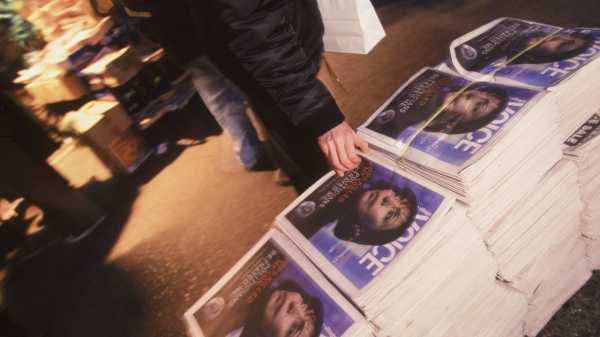
The last time I visited the Village Voice’s old, big newsroom, near Cooper Square, was three years ago, when I went seeking copies of columns that I had written between 1991 and 1998, during the third of my stints as the downtown weekly’s art critic. Like most of the paper’s archives, many of those pieces have survived only in bound volumes of dingy newsprint, never digitized and, in my case, long lost on a defunct laptop. Gaining entry to the locked premises was hard. The person who finally admitted me seemed surprised to see a visitor. A very few people, not appearing to be up to much, sat far apart at desks in a dimly lighted panorama of desuetude.
Between trips to a photocopier with the massive, sad tomes, I scanned the contents of numerous issues: products of passionate reporters, clued-in critics, brilliant writers, deft designers, and crackerjack photographers and cartoonists—too many, in each case, even to start mentioning here. The paper’s swaggering confidence and pizazz, instantly responsive to zigs and zags of the downtown Zeitgeist, startled me. I had forgotten. No one knew that history was loading a bullet with our name on it. On Friday, a year after the paper became online-only, the current owner, Peter Barbey, told the staff that it would no longer publish new material. He said that a few employees would stick around to work on a digital archive; the rest were laid off immediately.
My first time at the Voice, in 1966, was a fluke typical of the overnight mobilities of life and work in New York then. As a chaotic college-dropout poet and freelancer, subsisting on Avenue B, I had no credentials apart from hanging out with a lot of artists and having done some short (chiefly one-sentence) reviews for Art News. Someone at the Voice—eleven years past its founding, by Dan Wolf, Ed Fancher, and Norman Mailer—liked how I wrote. I wasn’t ready. In a contest between meeting deadlines and doing drugs, guess what won. But the brief elevation launched what I hadn’t yet imagined would become a career.
My second cruise, from 1980 to 1981, was wonderfully timed for a resurgence of energy in an art world that, like me, had drooped through the seventies. Then I blundered, jumping to the revived Vanity Fair before I was ready for it, or it for me. I wished to return to the Voice, but the fabulously acerbic Gary Indiana (who ended one column with this direct address to his readers: “Fuck you”) held the art-critic post by then. It seemed like every time I ran into Gary he said he was about to quit, but he didn’t quit—playing dog in the manger, in my exasperated view.
The Voice’s publisher at the time, David Schneiderman, reacted to the city’s rising prosperity in the eighties by trying to nudge the paper toward an upscale market, but was stymied by the staff’s entrenched counterculturalism. (Thank God for the contract of the Voice’s union, by the way, which would finance me through an otherwise bankrupting health crisis.) In 1988, Schneiderman effectively went into competition with himself with a new, stapled tabloid weekly, 7 Days, where I was employed once again. It was terrific (Adam Moss was the editor; Joan Acocella covered dance; we were a darn clever bunch) but doomed by the recession that shortly followed.
I rejoined the Voice two years later, after 7 Days shut down. It was like coming home. The next seven years—until, to my lasting wonderment, I was tapped by The New Yorker—were the most fun I’ve ever had as a critic. Among other things, I could consult with a canny photographer—first James Hamilton, then Robin Holland—to double the thrust, or the irony, of each column. I could take for granted a hip audience that required a minimum of exposition, and was game for jumping into the deep end of the subject at hand. I never worked at the office, but I recall a thrill nearly every time I entered it—headed to the desk of my editor, Jeff Weinstein or Vince Aletti—three blocks from my apartment, on St. Marks Place. The collective mind of the city streets seemed to flow through the door to catch glimpses of itself in a magic mirror.
Sourse: newyorker.com






